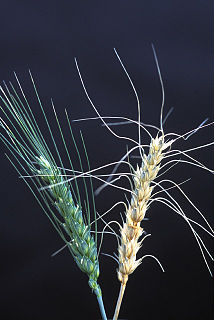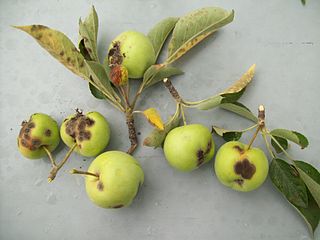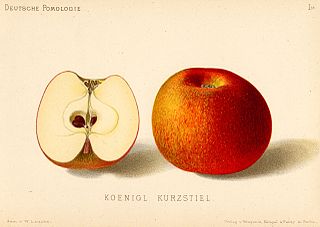
Fusarium ear blight (FEB), is a fungal disease of cereals, including wheat, barley, oats, rye and triticale. FEB is caused by a range of Fusarium fungi, which infects the heads of the crop, reducing grain yield. The disease is often associated with contamination by mycotoxins produced by the fungi already when the crop is growing in the field. The disease can cause severe economic losses as mycotoxin-contaminated grain cannot be sold for food or feed.
There are a number of lines of defence against pests and diseases in the orchard, principal among these being the practice of good husbandry, creating healthy soil and ensuring high standards of garden hygiene. But no matter how diverse and healthy the garden eco-system may be, there will always be a degree of disease and pest presence. In many ways, some level of pathogen population in the garden can be not only acceptable but desirable as they are indicative of a generally healthful and diverse environment, and add to the overall robustness of the system as an immunity to such detrimental influences will build up, particularly in a balanced polycultural regime. Indeed, most of the plants we grow will tend to be selected because they are trouble free, and those that are more susceptible to attack will have fallen by the wayside over time. However, most farmers find it unacceptable that the food crops they grow are damaged by pests.

Apple scab is a common disease of plants in the rose family (Rosaceae) that is caused by the ascomycete fungus Venturia inaequalis. While this disease affects several plant genera, including Sorbus, Cotoneaster, and Pyrus, it is most commonly associated with the infection of Malus trees, including species of flowering crabapple, as well as cultivated apple. The first symptoms of this disease are found in the foliage, blossoms, and developing fruits of affected trees, which develop dark, irregularly-shaped lesions upon infection. Although apple scab rarely kills its host, infection typically leads to fruit deformation and premature leaf and fruit drop, which enhance the susceptibility of the host plant to abiotic stress and secondary infection. The reduction of fruit quality and yield may result in crop losses of up to 70%, posing a significant threat to the profitability of apple producers. To reduce scab-related yield losses, growers often combine preventive practices, including sanitation and resistance breeding, with reactive measures, such as targeted fungicide or biocontrol treatments, to prevent the incidence and spread of apple scab in their crops.

Venturia inaequalis is an ascomycete fungus that causes the apple scab disease.
The Vivaldi potato is a cultivar of potato bred by HZPC, in the Netherlands, and then passed to 'Naturally Best', based in Lincolnshire, England, who promoted and distributed the potato in the UK.

Malus floribunda, common name Japanese flowering crabapple, Japanese crab, purple chokeberry, or showy crabapple, originates from Japan and East Asia. It may be a hybrid of M. sieboldii with M. baccata, in which case it would be written as Malus × floribunda.
The Golden Orange apple is an apple cultivar that was first developed in Italy in the 1970s by crossing PRI 1956-6 and Ed Gould Golden apples.
The Brina apple is an apple cultivar that was first developed in the Italy in the 1979s by open pollination PRI 2059-101 apples.
The 'Summerfree' is an apple cultivar first developed in Italy in the 1990s by crossing 'PRI 1956-6' and 'Ed Gould Golden' apples. Resistant to apple scab, it has a spreading habit with moderate vigor, the fruit are large with an average weight of 175 g, the skin is smooth, it ripens one to two months before 'Gala', and it has good storage ability.

Topaz is a cultivar of dessert apple that was developed in Czech Republic by the Institute of Experimental Botany for scab resistance. According to Orange Pippin it is "one of the best modern disease-resistant varieties, with fairly sharp flavour".

The Celebrity tomato cultivar is a hybrid (biology) that produces long fruit-bearing stems holding 20 or more very plump, robust tomatoes. Fruits weigh approximately 8 oz., and are 4 inches across. Plants need caging or staking, and produce fruit throughout the growing season. The celebrity tomato is a cultivar of the species Solanum lycopersicum. It is a crossbreed of the common tomato that is widely used for various culinary purposes. This tomato is of great size and is known to be resistant to most tomato diseases such as Fusarium wilt, Verticillium wilt, Tobacco mosaic virus and Root-knot nematode due to its hybrid nature. Celebrity tomatoes are highly adaptive to harsh environments and can grow in a wide range of places including dry, humid and wet regions. They are resistant to cracking and splitting which usually occurs when there is an excess of water and sugar movement in the fruits. Therefore, causing the tomato skin to grow at a slower rate compared to the expansion of the fruit. They can survive in harsh uneven rainfall. However, they are highly susceptible to colder environments and are at a higher risk of dying in regions with short growing seasons. The plants can grow up to 5 feet in height with bright red medium-sized fruits. The plants are generally very thick and grow in clusters. The tomato fruits are mostly used in the making of various salsas, salads, juices and canned food.

Pecan scab is the most economically significant disease of pecan trees in the southeastern United States. Venturia effusa is a fungal plant pathogen that causes pecan scab. The fungus causes lesions and tissue death on pecan twigs, petioles, leaves, nuts and shucks beginning in early spring, with multiple cycles of infection repeating until late summer. Wind and rain spread the fungus to a susceptible host. Control of the disease is achieved by fungicide, sanitation and, in some cases, quarantine.
Applecrabs are various hybrids between crabapples and apples. They are bred for varying reasons, including disease resistance and use in cold climates because they are often hardier than apple trees and their fruit has the good eating qualities of apples.

Rajka is a hybrid cultivar of domesticated apple from the Czech Republic, specifically for eating. Rajka was crossed and developed by the Institute of Experimental Botany from the Champion and Katka apples for scab resistance, hence possible to grow organic.

Pristine apple is a hybrid cultivar of 'Co Op 10' x 'Camuzat' domesticated apples, which are descendants of the 'McIntosh' apple and the 'Starking Delicious'. This cultivar was developed and patented in the United States by the PRI disease resistant apple breeding program, in Indiana, United States in 1994, for its resistance to apple scab. It is susceptible to cedar-apple rust.
The PRI disease resistant apple breeding program is a joint project of the Purdue University, Rutgers University, and the University of Illinois, to breed apple cultivars to be resistant to apple scab. PRI stands for 'P'urdue, 'R'utgers and 'I'llinois.

'Ariane' is a modern cultivar of domesticated apple that was recently developed in France for scab resistance.

Court Pendu Plat is an extremely old French cultivar of domesticated apple that was first recorded in 1613. The cultivar definitely dates back to earlier than the 17th century, and was probably cultivated by the Romans. It is known for its intense flavor which mellows with storage.
Enterprise is a modern bred, late-ripening and attractive, red cultivar of domesticated apple with excellent fruit quality combined with disease resistance to scab, cedar apple rust, fire blight and some resistance to powdery mildew. The fruit is large and attractive and retains excellent fresh quality for up to six months at 1°C. Its moderate acidity at time of harvest mellows in storage, and it is best after one month of storage.
Aia Ilu is a cultivar of domesticated apple, from Estonia, first developed in 1946 by Aleksander Siimon.












